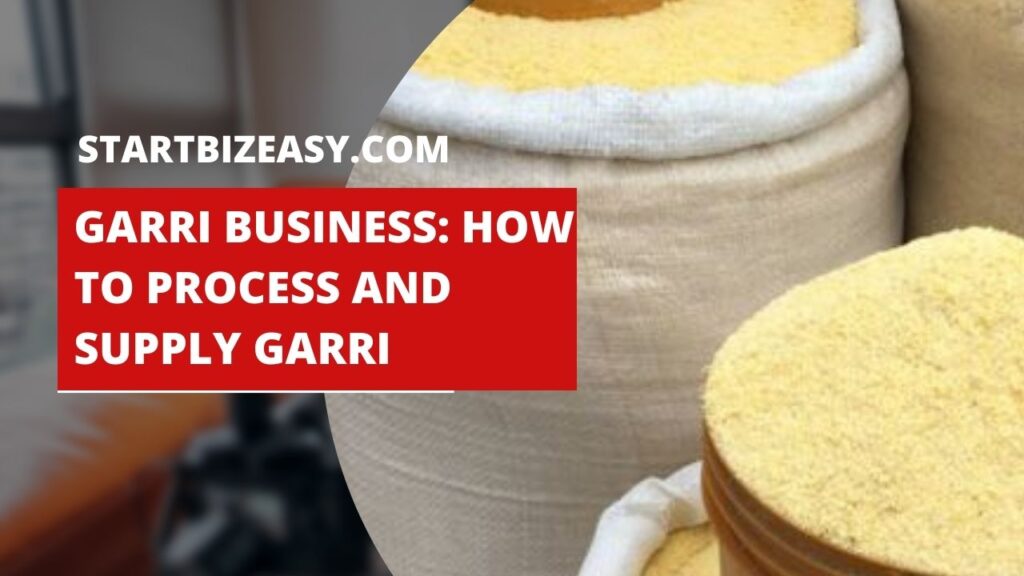
The Garri business refers to the production, processing, and commercialization of garri, a staple food derived from cassava tubers. Garri is a popular food item in West Africa, particularly in Nigeria, Ghana, and Sierra Leone. The business encompasses various stages, from cassava cultivation to the final packaging and distribution of garri to consumers.
- Cassava Cultivation: The first step in the garri business is the cultivation of cassava, a root crop that thrives in tropical climates. Farmers prepare the land, plant cassava stems, and nurture the crop until it matures, typically within 6 to 18 months, depending on the variety.
- Harvesting: Once mature, cassava tubers are harvested from the ground. This process involves manually uprooting the plants and collecting the tubers.
- Processing: The harvested cassava tubers undergo several processing steps to transform them into garri. These steps include:
- Peeling: Removing the outer skin of the cassava tubers.
- Grating: Grating the peeled tubers into a pulp.
- Fermentation: Allowing the grated pulp to ferment for 1 to 3 days. Fermentation helps reduce the cyanide content in the cassava and enhances its flavor.
- Pressing: Squeezing out excess water from the fermented pulp using a press.
- Sieving: Sieving the pressed pulp to remove fibrous materials.
- Roasting: Roasting the sieved pulp in a large pan over an open fire to produce dry, crispy garri granules.
- Packaging: After roasting, the garri is allowed to cool and is then packaged into bags or containers for storage and transportation.
- Distribution and Marketing: The final stage involves distributing the packaged garri to various markets, retailers, and consumers. This may include local markets, supermarkets, and export markets.
The Garri business is profitable and significant for several reasons. It provides a source of livelihood for many farmers, processors, and traders. It also contributes to food security in the region, as garri is an affordable and readily available food item. Furthermore, the business has potential for growth and expansion, with opportunities for value addition, such as fortifying garri with vitamins and minerals or developing new products from cassava by-products.
We are going to start this article by unraveling the step-by-step guide to starting a Garri business.
Table of Contents
Step-By-Step Guide to Starting a Garri Processing Business.
1. Research and Planning:
The foundation of your garri processing business lies in thorough research and planning. To start, you should identify the demand for garri in your target market, which includes both local and regional areas. Understanding the demand will give you insights into the potential scale of your business and the opportunities available.
Next, analyze your competitors. By studying other garri producers, you can gain valuable insights into their strengths and weaknesses. This analysis will help you identify gaps in the market that you can exploit, as well as best practices that you can adopt. Pay attention to their pricing strategies, distribution channels, and the quality of their products.
Learning about consumer preferences is another crucial step. You need to understand what types of garri your potential customers favor—whether it’s white or yellow garri. Additionally, take note of their preferred packaging sizes and quality expectations. This information will guide you in creating products that meet or exceed consumer demands, giving you a competitive edge.
With all this information at hand, you can craft a comprehensive business plan. Your business plan should clearly outline your goals, providing a roadmap for your business journey. Include a detailed market analysis that summarizes your research findings and highlights the opportunities and threats in the market.
Your production strategy should detail how you plan to source cassava, the processing methods you will use, and the quality control measures you will implement. This section should also outline the logistical aspects of your business, such as the location of your processing facility and the equipment you will need.
Financial projections are essential for understanding the viability of your business. Include detailed estimates of startup costs, operating expenses, and projected revenues. This section should also highlight your funding requirements and potential sources of capital.
Finally, your marketing approach should outline how you plan to promote your garri products and reach your target customers. Detail the marketing channels you will use, such as social media, local markets, and supermarkets. Additionally, describe your branding strategy and how you will position your products in the market.
2. Secure Funding:
The capital needed to start a local garri processing business in Nigeria ranges from ₦1,580,000 to ₦2,180,000. For a standard garri processing business, the capital ranges from ₦6,650,000 to ₦9,000,000. These cost can be vary based on location, scale, and specific business requirements.
The capital will be spent on the following items:
- Land and Facility
- Equipment
- Raw Materials
- Operating Expenses
- Miscellaneous such as Packaging materials, licenses. and permits and other contingencies
Once you have a clear plan, the next step is to secure the necessary funding for your garri processing business.
There are several ways you can fund your business. One option is to use your personal savings. This can provide you with the initial capital needed to start your business without incurring debt. However, it is important to ensure that you do not deplete your personal savings entirely, as this could put your financial stability at risk.
Another option is to apply for business loans. Banks and microfinance institutions offer loans specifically designed for small and medium enterprises. When seeking a loan, you will need to present your comprehensive business plan to demonstrate the viability of your business and your ability to repay the loan. Be prepared to discuss your financial projections, market research, and production strategies in detail.
You may also consider seeking investors. Investors can provide substantial funding in exchange for equity or a share of the profits. To attract investors, you will need to convincingly present your business plan and highlight the potential returns on their investment. Look for investors who have an interest in agricultural ventures and who can also offer valuable advice and connections within the industry.
Exploring grants and subsidies is another viable option. Government agencies and non-governmental organizations (NGOs) often provide financial assistance to support agricultural projects. Research available grants and subsidies in your region and apply for those that align with your business goals. These funds can significantly reduce your financial burden and provide you with the resources needed to start and grow your business.
Securing the necessary funding is a critical step in bringing your garri processing business to life. By carefully assessing your financial needs and exploring various funding options, you can ensure that you have the capital required to start and sustain your business, paving the way for future success.
3. Legal Requirements:
To operate your garri processing business legally, you must obtain the necessary permits and licenses. The first step is to register your business with the Corporate Affairs Commission. This process typically involves choosing a business name, completing registration forms, and paying the required fees. Registering your business formalizes your operations and provides legal recognition, which is essential for opening a business bank account and entering into contracts.
Next, you need to obtain food safety certifications. These certifications ensure that your production processes meet the regulatory standards set by food safety authorities. Compliance with these standards is crucial, as it guarantees that your garri is safe for consumption. Food safety certifications often require you to implement specific hygiene practices, maintain clean processing facilities, and ensure that your products are free from contaminants.
Additionally, securing environmental permits is vital for complying with local environmental regulations. These permits ensure that your business operations do not harm the environment. Depending on your location, you may need to adhere to regulations regarding waste disposal, water usage, and emissions. Obtaining environmental permits typically involves submitting an environmental impact assessment and demonstrating that your business practices are sustainable and eco-friendly.
Meeting these legal requirements not only helps you avoid potential legal issues but also builds trust with your customers. When customers see that your business is registered and certified, they are more likely to trust the quality and safety of your garri. Furthermore, compliance with legal and regulatory standards enhances your business reputation and can open doors to additional opportunities, such as partnerships and access to new markets.
4. Acquire Land and Equipment:
Selecting the right location for your garri processing facility is crucial to the success of your business. You should choose a site that is strategically located, ensuring it is easily accessible to both raw materials and your target markets.
Proximity to cassava farms will reduce transportation costs and ensure a steady supply of fresh cassava tubers. Additionally, being close to your target markets will facilitate efficient distribution and timely delivery of your finished products.
Once you have secured the land, your next step is to invest in the necessary equipment. Each piece of equipment plays a vital role in the garri production process. Start with cassava peelers, which are essential for removing the outer skin of the cassava tubers efficiently. Graters will help you shred the peeled cassava into fine pulp, which is then ready for fermentation.
Fermentation tanks are crucial for the fermentation process, which enhances the flavor of the garri and reduces its cyanide content. After fermentation, you will need presses to squeeze out the excess water from the pulp. Sieves are used to remove any remaining fibrous materials, ensuring a smooth and uniform texture for the garri.
Roasting pans are necessary for the final step of the production process, where the sieved pulp is roasted to produce dry, crispy garri granules. Investing in high-quality roasting pans will help you achieve a consistent roasting temperature, resulting in a superior product.
The local equipment needed for garri processing:
- Graters: Used to grate the peeled cassava tubers into a fine pulp. Graters can be manual or mechanized, with mechanized graters providing higher efficiency.
- Fermenting Tanks: These tanks are used to hold the grated cassava pulp during the fermentation process, which lasts 2-3 days.
- Hydraulic Presses: Used to press the fermented pulp to remove excess water. This step is essential for achieving the correct texture in the final product.
- Sieves: After pressing, the pulp is sieved to remove any fibrous materials and ensure a fine consistency.
- Frying Pans: Large shallow pans are used for frying or roasting the sieved pulp until it becomes dry and granular.
Additionally, ensure that you have adequate storage facilities for both raw cassava and finished garri. Proper storage is essential to maintain the quality and freshness of your products. Raw cassava should be stored in a cool, dry place to prevent spoilage and ensure it remains suitable for processing.
Finished garri also needs to be stored in airtight containers to protect it from moisture and pests. Proper storage facilities will help you maintain the quality of your garri from production to the point of sale, ensuring customer satisfaction.
By carefully selecting your location and investing in the right equipment, you set a strong foundation for your garri processing business. Efficient and well-maintained equipment not only improves productivity but also ensures that your products meet high-quality standards. Proper storage facilities further guarantee that your garri retains its freshness and quality, which is crucial for building a reputable brand and achieving long-term success.
5. Source Quality Cassava Tubers:
The quality of your garri depends significantly on the quality of your cassava tubers. To ensure that your final product meets high standards, you need to source the best possible raw materials. Begin by establishing relationships with reliable suppliers who can consistently provide high-quality cassava. Look for suppliers who have a reputation for delivering fresh, healthy tubers and who can meet your demand in terms of quantity and regularity. Building strong relationships with these suppliers will help secure a steady supply of the raw materials you need for your production process.
Alternatively, you might consider cultivating your own cassava. By growing your own cassava, you gain greater control over the quality and availability of your raw materials. This approach allows you to implement best farming practices, select high-yield cassava varieties, and harvest tubers at their optimal maturity. Although this option requires a significant initial investment in land, labor, and farming equipment, it can ultimately lead to cost savings and higher-quality produce.
Cultivating your own cassava also ensures that you have a consistent supply, reducing your dependence on external suppliers and mitigating the risk of supply chain disruptions. This level of control can be particularly beneficial during peak production periods or when there are market fluctuations in the availability of cassava tubers.
Whether you choose to source cassava from reliable suppliers or grow your own, ensuring the quality of your raw materials is essential for producing superior garri. High-quality cassava tubers will result in a better-tasting and more nutritious product, which is crucial for building a strong brand and satisfying your customers. By prioritizing the quality of your cassava, you lay the groundwork for a successful and reputable garri processing business.
6. Setup Processing Facility:
With your land and equipment in place, you can now set up your garri processing facility. It is crucial to organize the layout to optimize workflow and efficiency. Begin by designing a floor plan that minimizes the distance between different stages of production, from peeling and grating to fermentation, pressing, sieving, and roasting. This streamlined arrangement will enhance productivity and reduce the time and effort required to move materials and products between stations.
Besides, here are the equipments needed to run both a local and standard Garri processing facility:
- Cassava Peeler: Removes the outer skin of cassava tubers
- Cassava Grater: Grates the peeled cassava tubers into a fine pulp
- Fermenting Tanks: Holds the grated cassava pulp during the fermentation process.
- Hydraulic Press: Presses the fermented pulp to remove excess water.
- Sieves: Removes fibrous materials from the pressed cassava pulp.
- Frying Pans/Roasting Equipment: Fries or roasts the sieved pulp until it becomes dry and granular.
- Dryers: Dries the garri further to ensure proper moisture content.
- Packaging Machine: Packages the finished garri into moisture-proof and hygienic packaging materials.
- Weighing Scales: Measures the garri accurately for packaging and sales.
- Storage Bins: Stores the processed garri before packaging.
- Water Supply System: Provides a steady supply of clean water for washing and processing cassava.
- Power Supply System: Ensures a consistent power supply for all mechanized equipment.
- Safety Equipment: Ensures the safety and health of workers.
Ensure that your facility adheres to strict hygiene and safety standards. This is essential for producing high-quality garri that is safe for consumption. Establish clear protocols for cleanliness, such as regular sanitation of equipment and workspaces, proper waste disposal, and ensuring that staff adhere to personal hygiene practices. Implementing these measures will help prevent contamination and maintain the integrity of your product.
Incorporate quality control measures at each step of the production process. For instance, inspect cassava tubers upon arrival to ensure they meet your quality standards. Monitor the fermentation process to achieve the desired texture and flavor of the garri. Regularly check the efficiency of presses and sieves to ensure consistent removal of water and fibers. Pay particular attention to the roasting process, as maintaining the correct temperature is crucial for producing the desired crispy granules.
Quality control should also extend to packaging and storage. Ensure that garri is packaged in clean, airtight containers to preserve its freshness and prevent moisture ingress. Label packages with relevant information, such as production date and expiration date, to help maintain transparency and trust with your customers. Store the finished products in a cool, dry place to extend shelf life and maintain quality.
By carefully setting up your processing facility with an efficient layout, stringent hygiene and safety standards, and robust quality control measures, you create an environment that supports the production of high-quality garri. This attention to detail will help you meet consumer expectations and build a strong reputation for your brand, laying the foundation for the success of your garri processing business.
7. Hire and Train Staff:
Recruit skilled workers for various stages of production, including peeling, grating, fermenting, pressing, sieving, and roasting. Provide comprehensive training to ensure your staff understands the processing techniques, hygiene practices, and equipment operation. Well-trained staff will contribute significantly to the efficiency and quality of your production process.
8. Production Process:
Now, you can begin the production process for your garri. Each step is crucial in ensuring the final product meets the desired quality and taste. Here’s a detailed explanation of each stage:
1. Peeling: The first step is peeling, where you remove the outer skin of the cassava tubers. This step is essential to eliminate any dirt, pesticides, or contaminants that may be present on the surface. Use cassava peelers to efficiently and thoroughly remove the skin, preparing the tubers for the next stage.
2. Grating: Once peeled, the cassava tubers need to be grated into a fine pulp. Grating breaks down the tubers into smaller particles, making it easier to ferment and process further. Use industrial graters to ensure a consistent and fine texture, which is important for the quality of the final garri product.
3. Fermentation: Fermentation is a critical step in the garri production process. Ferment the grated cassava pulp for 1-3 days. This fermentation period allows the natural processes to enhance the flavor and reduce the cyanide content in the cassava. Proper fermentation is key to producing safe and tasty garri, so monitor the process closely to achieve the desired results.
4. Pressing: After fermentation, the next step is pressing the fermented pulp to remove excess water. Use hydraulic presses to squeeze out as much moisture as possible. This step is important to reduce the water content in the pulp, making it easier to sieve and roast later. Proper pressing ensures the garri has the right texture and consistency.
5. Sieving: Sieving the pressed pulp helps remove any fibrous materials that may be left. Use fine sieves to separate the fibers from the pulp, ensuring a smooth and uniform texture for the garri. This step is essential to improve the quality and appearance of the final product.
6. Roasting: The final step is roasting the sieved pulp to produce dry, crispy garri granules. Use mechanical roasting pans to maintain a consistent temperature throughout the roasting process. Roasting transforms the moist pulp into the dry, crispy granules that characterize garri. Ensure that the roasting temperature is well-controlled to prevent burning and achieve the perfect texture and flavor.
By following these steps meticulously, you can produce high-quality garri that meets consumer expectations. Each stage in the production process contributes to the overall quality, taste, and safety of your product, ensuring you deliver a superior product to the market.
9. Packaging and Storage:
After production, package the garri in suitable bags or containers, ensuring they are airtight to prevent moisture ingress. Properly label the packages with product information, expiration dates, and brand details. Store the packaged garri in a cool, dry place to maintain freshness and quality until it reaches your customers.
10. Marketing and Sales:
To successfully promote and sell your garri, you need to develop a robust marketing and sales strategy. Start by creating a strong brand identity that resonates with your target audience. Your brand should convey the quality, authenticity, and benefits of your garri. Consider designing an appealing logo and packaging that stand out and communicate the essence of your product.
Utilize various marketing channels to reach a wider audience. Social media platforms like Facebook, Instagram, and Twitter are excellent for building brand awareness and engaging with potential customers. Share posts that highlight the unique qualities of your garri, such as its taste, nutritional benefits, and production process. You can also use these platforms to run targeted advertising campaigns that reach specific demographics.
Local markets and supermarkets are vital for reaching customers who prefer to buy their food products in person. Establish relationships with market vendors and supermarket chains to get your garri on their shelves. Offer product samples and conduct tastings to attract new customers and encourage them to try your garri.
Online platforms provide another avenue for sales and marketing. Create a user-friendly website where customers can learn about your garri and place orders. Consider partnering with e-commerce platforms to expand your reach. Online sales channels are particularly useful for reaching customers who prefer the convenience of home delivery.
A reliable distribution network is essential for ensuring that your garri reaches your customers efficiently. Work with logistics providers who can handle the transportation and delivery of your products. Ensure that your distribution network is well-coordinated to prevent delays and maintain the quality of your garri during transit.
Regularly monitor your sales performance and customer feedback. Analyze sales data to identify trends and areas for improvement. Pay attention to customer reviews and comments to understand their preferences and any issues they may have encountered. Use this information to refine your products and adjust your marketing strategies accordingly.
How to Start a Garri Supply Business
Starting a garri supply business involves a series of well-planned steps to ensure success and sustainability. Here’s a detailed guide to help you get started:
Research and Planning
Begin by conducting thorough research and planning. Identify the demand for garri in your target markets, including both local and regional areas (all depends on your capacity). Understand the preferences of your potential customers, such as the types of garri they prefer (white or yellow), packaging sizes, and quality expectations. Analyze your competitors to learn about their strengths, weaknesses, and market strategies. This information will help you develop a comprehensive business plan outlining your goals, market analysis, supply chain strategy, financial projections, and marketing approach.
Secure Funding
Once you have a clear plan, assess your financial needs, including startup costs, transportation, and initial inventory. For a Garri supply business, you will need a minimum of N500,000 Naira if your goal is to supply on a regional scope, but if is going to be supplying just within your locality, N50k to N100k should be enough You may choose to fund your business through personal savings, business loans from banks or microfinance institutions, investors, or grants from government agencies or NGOs. Having a solid financial foundation will enable you to procure quality garri and cover operational expenses.
Legal Requirements
To operate legally, you must obtain the necessary permits and licenses. Register your business with the appropriate government authorities to formalize your operations. Obtain food safety certifications to ensure your garri meets regulatory standards. Additionally, secure any required environmental permits to comply with local environmental regulations. Adhering to these legal requirements will help you avoid potential legal issues and build trust with your customers.
Source Quality Garri
The success of your garri supply business depends on the quality of your product. Establish relationships with reliable producers or suppliers who can provide high-quality garri consistently. Alternatively, you can collaborate with local farmers to source fresh cassava and process the garri yourself, ensuring control over the quality and supply of your product.
Setup Storage and Distribution Facilities
Having adequate storage facilities is essential for maintaining the quality and freshness of your garri. Ensure that your storage area is clean, dry, and free from pests. Proper packaging and labeling of your garri will also help preserve its quality and appeal to customers. Develop a reliable distribution network to deliver your garri efficiently to your target markets. Work with logistics providers to handle transportation and delivery, ensuring timely and safe arrival of your products.
Develop a Marketing and Sales Strategy
Create a strong brand identity that resonates with your target audience. Utilize various marketing channels to promote your garri, such as social media, local markets, supermarkets, and online platforms. Social media platforms can help build brand awareness and engage with customers through posts, ads, and promotions. Establish relationships with local market vendors and supermarket chains to get your garri on their shelves. Consider creating an e-commerce website for online sales, offering convenience for customers who prefer home delivery.
Monitor Performance and Adapt
Regularly monitor your sales performance and customer feedback to identify areas for improvement. Analyze sales data to understand trends and make informed decisions about inventory and marketing strategies. Pay attention to customer reviews to address any issues and refine your product offerings. Continuously adapting your strategies based on market feedback will help you stay competitive and meet customer expectations.
Business Opportunities in the Garri Business
The garri business offers numerous lucrative opportunities for you to explore. By identifying and leveraging these opportunities, you can build a successful and profitable venture. Here are some key business opportunities in the garri industry:
1. Production and Supply
Starting with the production and supply of garri itself is a primary opportunity. By setting up a garri processing facility, you can produce high-quality garri to meet local and regional demand. Focus on maintaining consistency and quality to build a strong brand reputation. You can supply garri to local markets, supermarkets, and wholesalers. Ensuring a steady supply of high-quality garri will help you establish a loyal customer base and generate significant revenue.
2. Value-Added Products
Consider diversifying your product line by creating value-added products from garri. This can include flavored garri, instant garri packs, and garri-based snacks. Flavored garri, such as those infused with coconut or ginger, can attract a niche market. Instant garri packs, which require minimal preparation, appeal to busy consumers and students. Garri-based snacks, like garri cookies or biscuits, offer another avenue for product innovation. These value-added products can command higher prices and increase your profitability.
3. Packaging and Branding
Innovative packaging and branding present another significant business opportunity. Attractive and convenient packaging can make your garri stand out on store shelves and appeal to modern consumers. Invest in eco-friendly and resealable packaging options to enhance product appeal and shelf life. Strong branding, including a memorable logo and compelling brand story, will help you connect with your target audience and build brand loyalty.
4. Export Markets
Exploring export markets can significantly expand your business reach and revenue. There is a growing demand for African foods, including garri, in the international market. Identify countries with a significant African diaspora and work with export agencies to navigate the necessary regulations and logistics. Exporting garri allows you to tap into a larger customer base and diversify your revenue streams.
5. Agritourism and Education
Agritourism and educational programs related to garri production offer unique business opportunities. You can create a garri processing farm that offers tours and hands-on experiences for tourists and students. This not only generates additional revenue but also raises awareness about the importance of cassava and garri in African culture. Educational programs and workshops can attract schools and institutions looking for cultural and agricultural learning experiences.
6. Online Sales and E-Commerce
The rise of e-commerce presents an excellent opportunity to sell garri online. Develop an e-commerce website where customers can purchase your garri and value-added products. Utilize online marketplaces and social media platforms to reach a wider audience. Offering nationwide and international shipping options can further expand your customer base. Online sales provide convenience for customers and can significantly boost your sales volume.
7. Contract Processing
Offering contract processing services to other farmers or small-scale producers is another viable business opportunity. Many farmers may not have the resources or equipment to process their cassava into garri. By providing processing services, you can generate additional income while helping other producers add value to their crops. This creates a win-win situation where you earn processing fees, and the farmers benefit from higher-value products.
By exploring these business opportunities in the garri industry, you can diversify your revenue streams and build a successful enterprise worth in millions. Whether you focus on production, value-added products, export markets, agritourism, online sales, or contract processing, there is significant potential for growth and profitability in the garri business. Your commitment to quality, innovation, and customer satisfaction will be key to capitalizing on these opportunities and achieving long-term success.
Challenges in the Garri Business
While the garri business offers numerous opportunities, you should be prepared to face several challenges. Understanding these challenges and planning how to address them will be crucial to your success. Here are some of the key challenges in the garri business:
1. Quality Control: Maintaining consistent quality is one of the biggest challenges in the garri business. Variations in the quality of raw cassava, differences in processing techniques, and inconsistencies in fermentation and roasting can affect the final product. You need to implement stringent quality control measures at each stage of production to ensure your garri meets high standards. This includes regular inspections, standardizing processes, and training staff on best practices.
2. Supply Chain Management: Ensuring a consistent supply of high-quality cassava tubers can be challenging. Factors such as seasonal variations, weather conditions, and transportation issues can disrupt your supply chain. Establishing strong relationships with reliable suppliers and potentially diversifying your sources can help mitigate this risk. You might also consider cultivating your own cassava to gain more control over the supply chain.
3. Competition: The garri market is highly competitive, with many producers and suppliers vying for market share. To stand out, you need to differentiate your product through quality, branding, and unique selling points. Innovating with value-added products, attractive packaging, and strong marketing strategies will help you compete effectively. Understanding your competitors and continuously improving your offerings is essential to maintaining a competitive edge.
4. Regulatory Compliance: Navigating the regulatory landscape can be complex. You must comply with food safety standards, obtain necessary permits and licenses, and adhere to environmental regulations. Staying updated on regulatory requirements and ensuring your operations meet these standards is crucial to avoid legal issues and build customer trust. Investing in proper documentation and certification processes is important for long-term success.
5. Market Fluctuations: Market demand for garri can fluctuate due to economic conditions, changes in consumer preferences, and competition from other food products. You need to be adaptable and responsive to market trends. Diversifying your product line and exploring new markets, such as exports, can help mitigate the impact of market fluctuations. Regular market research and staying attuned to consumer feedback will allow you to adjust your strategies accordingly.
6. Financial Management: Effective financial management is critical for sustaining and growing your garri business. You need to carefully manage your cash flow, control costs, and make strategic investments. Access to capital for scaling your operations or navigating financial challenges can be limited. Developing a strong financial plan, seeking reliable funding sources, and maintaining accurate financial records will help you manage your finances effectively.
7. Technological Advancements: Keeping up with technological advancements in the garri processing industry can be challenging but necessary for improving efficiency and product quality. Investing in modern equipment and technology requires significant capital but can lead to long-term benefits. You need to stay informed about the latest innovations and consider upgrading your processes to remain competitive.
8. Environmental Sustainability: Addressing environmental concerns is becoming increasingly important. Cassava farming and garri processing can have environmental impacts, such as soil degradation and waste management issues. Implementing sustainable farming practices, waste recycling, and eco-friendly packaging can help reduce your environmental footprint. Being proactive about sustainability can also enhance your brand image and appeal to environmentally conscious consumers.
By understanding and addressing these challenges, you can better prepare yourself for the complexities of the garri business. Implementing robust quality control measures, managing your supply chain effectively, staying competitive, complying with regulations, adapting to market changes, managing your finances well, embracing technological advancements, and focusing on sustainability will be key to overcoming these challenges and achieving success in the garri industry.





